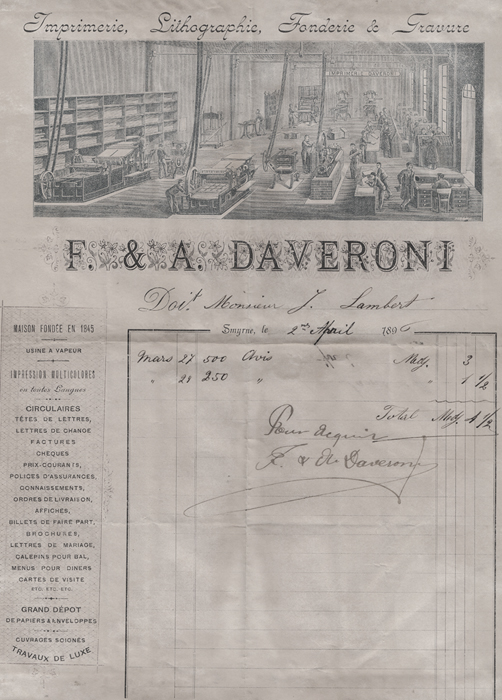
Ephemera
St John’s Church Archives
This is one of the 3 standing Anglican Churches in Izmir and the last one to be built at 1899-1900. It location in northern Punta ensured the Great Fire of Smyrna of 1922 didn’t reach it, so it was spared possible total destruction. Road widening in the 1980s led to it losing a considerable amount of garden and a 1964 mob attack almost burnt it down. It still has a thriving congregation.
This invoince from the local Levantine company Daveroni from 1896 to a Mr J. Lambert may have nothing to do with the church as it appears to be for a boiler, perhaps for the parsonage (present day British Consulate) constructed first next to the church.
An accounts sheet from 24 October 1896 for the yet to be constructed St John’s Church, managed by the local C. Whittall & Co., with the consular bill for the firman (Sultan’s permission to erect the church - appears to be over 100,000 piastres) set against all the donations, the bulk coming from London, presumably the Foreign Office?

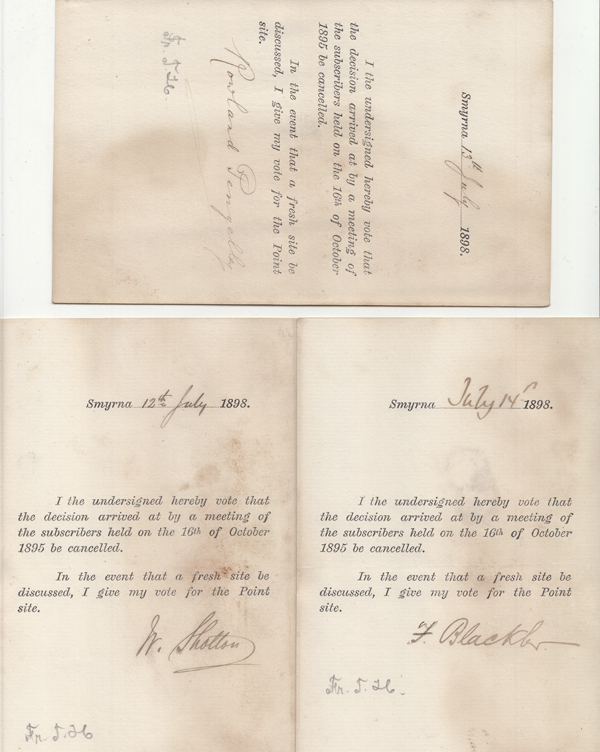
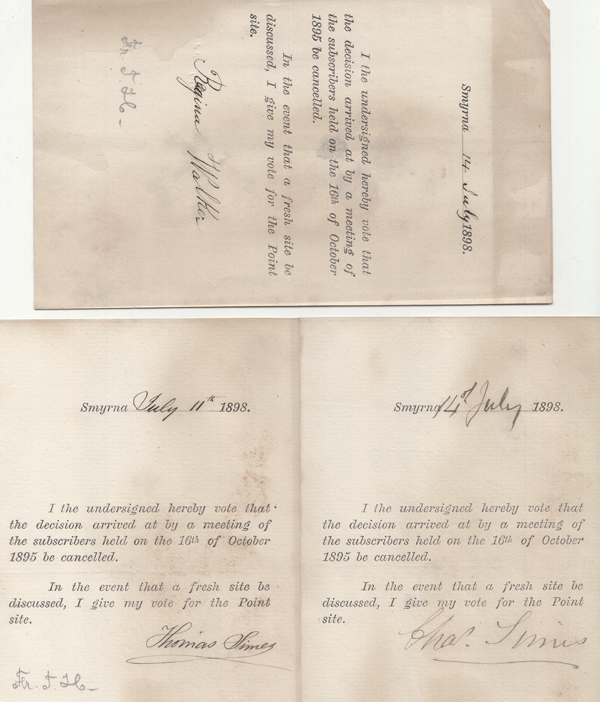
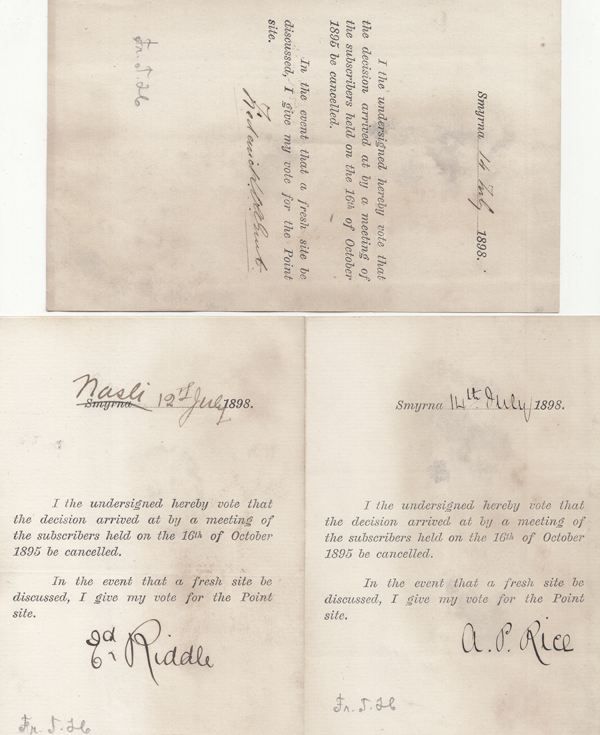
A selection of a larger number of voting casting cards by members of the Anglican congregation, cast in July 1898. All returns from this ballot seem to favour the ‘Point’ location, near the Alsancak train station as opposed to the ‘Old Hospital’ location equating a lot nearer the city centre of Konak. It is not clear if only the ‘Yes’ cards were retained, so the voting might not have been unanimous? The recorded names with their signature include: ? Riddle, A.P. Rice, E.A. Magnifico, Roland Pengelley, ? Shotton, F. Blackler, Regina Walker, Thomas Simes, Chas. Simes, Frederick W.A. Gout.
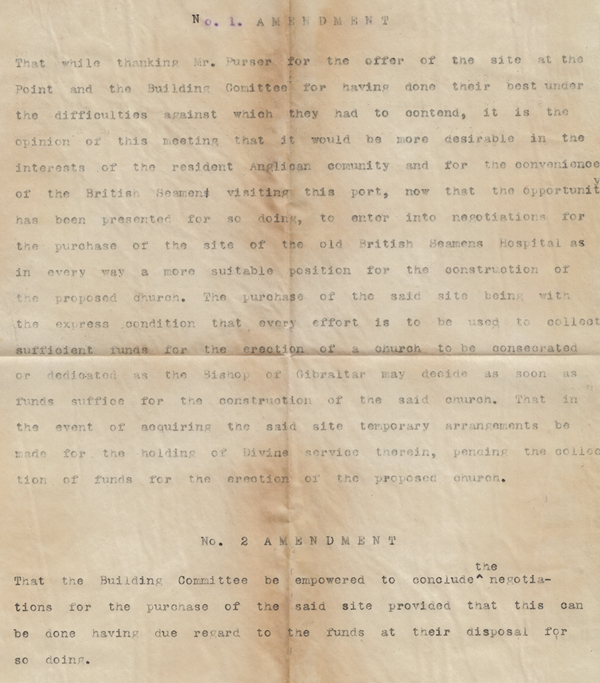
What appear to be decisions listed by the Church committee around 1896-9, thanking Edward Purser (the manager of the Ottoman Railway Company) for donating the land for the church but also requesting the purchase of the nearby site of the old British Seaman’s Hospital (presumably from the British Government) ‘as in everyway a more suitable position’ - not made clear why it is a superior location. In the event Mr Purser’s land plot, which presumably had no house on it, was where the church was built.
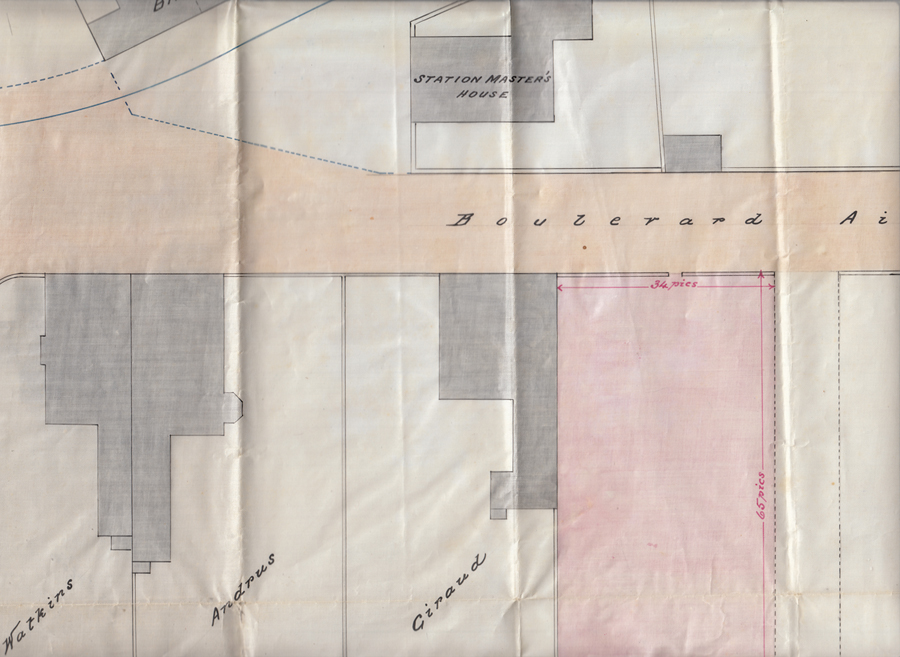
Groundplan from 1898 showing the location of the soon to be constructed church and neighbouring plots with owners surnames indicated - full map:
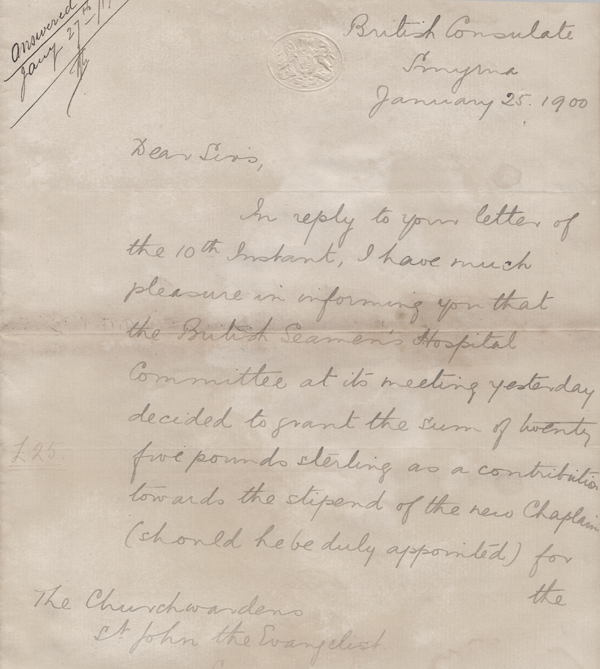
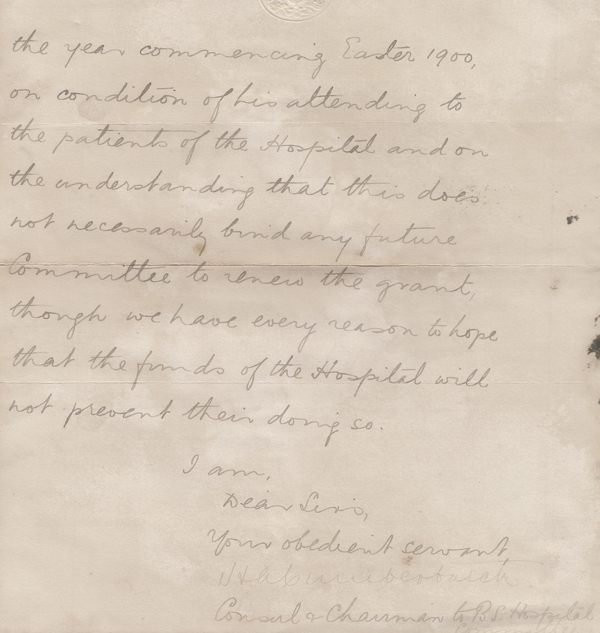
Letter from 1900 from the British Consulate in Smyrna informing the churchwardens at St John the Evangelist that the British Seamen’s Committee had decided to financially help the soon to be appointed Chaplain, with certain conditions attached.
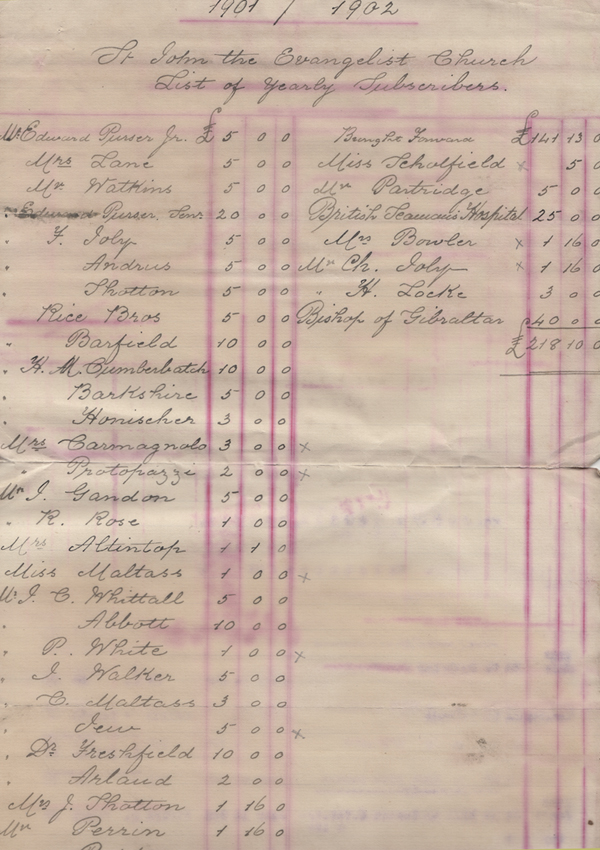
St John the Evangelist Church List of yearly subscribers for 1901/1902 period, to aid its construction, coming to a total of £218 (equivalent to over £17,000 today), with the biggest contribution coming from the Bishop of Gibraltar in whose diocese the church was / is.
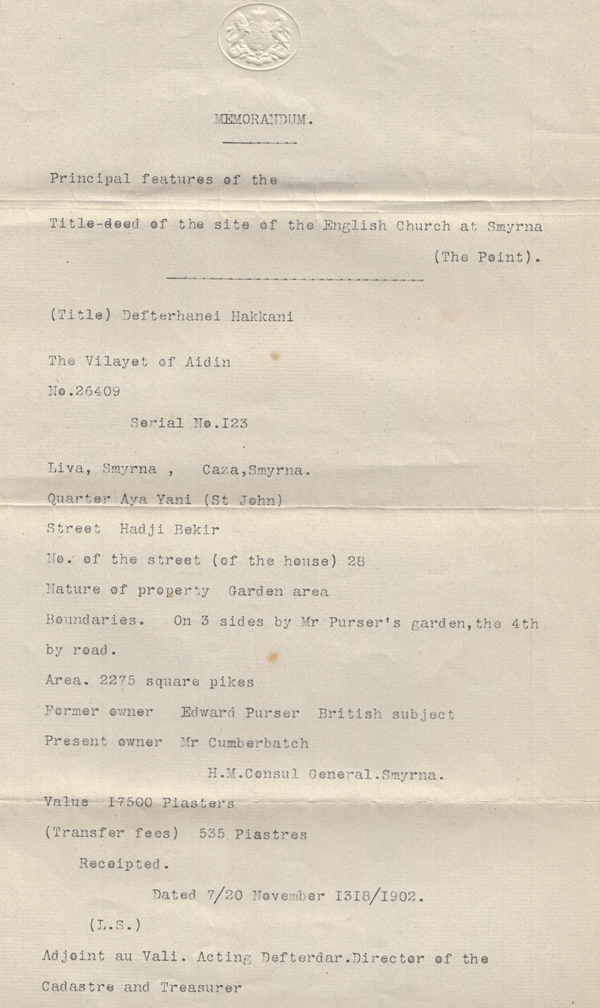
What appears to be the Consular English translation of the title-deed of the St John’s Church, drawn up in 1902, showing the ownership now being registered under the Consul General of the time Mr Henry A. Cumberbatch, as Ottoman law didn’t allow for foundations to be the deed holder.
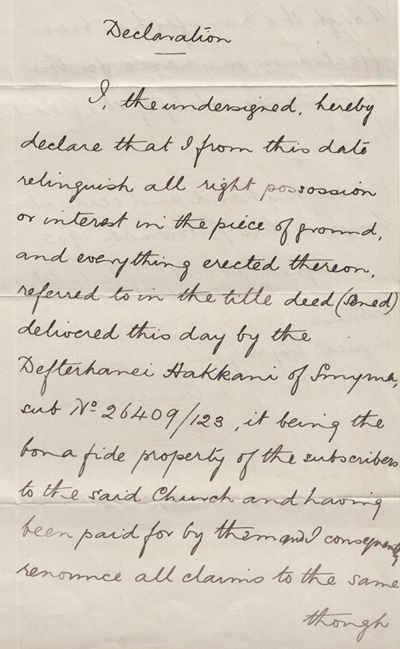
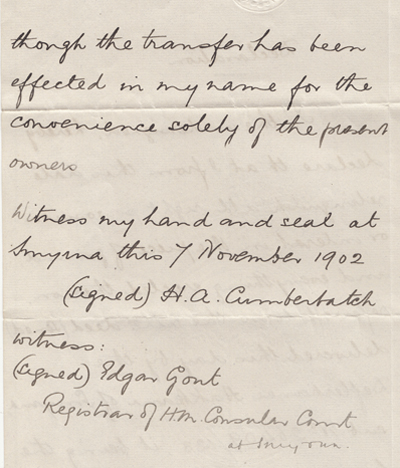
Consular document signed by the Consul Cumberbatch renouncing any claims on the land which he symbolically owned, 7 November 1902.
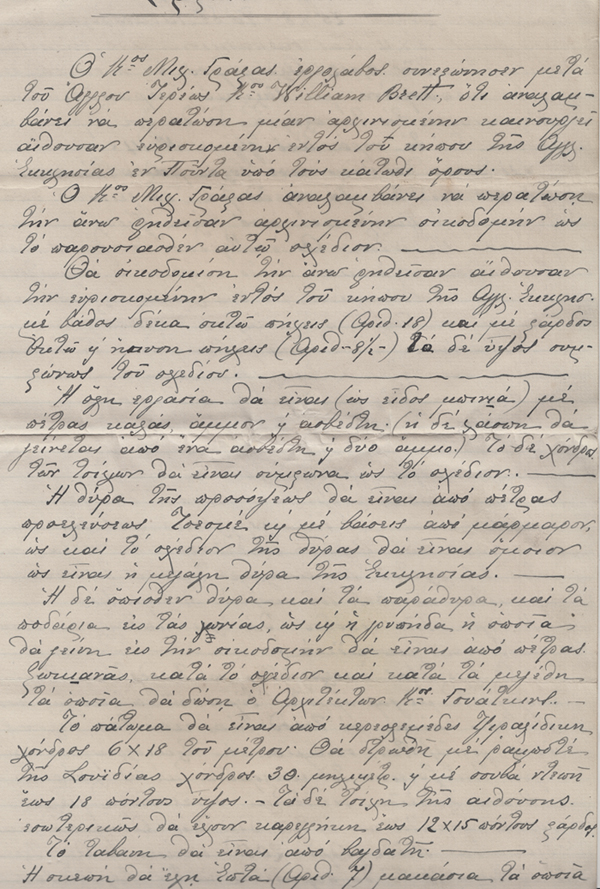
An undated document in Greek, written by Michalis Graksas - developer for the agreed construction of the church hall for St John’s Anglican Church within the garden, with the current priest William Brett co-signatory to a detailed specifications for doors, floors etc. The Bishop Collins Memorial Hall was erected in 1913 so this document is clearly a year or two before that date.
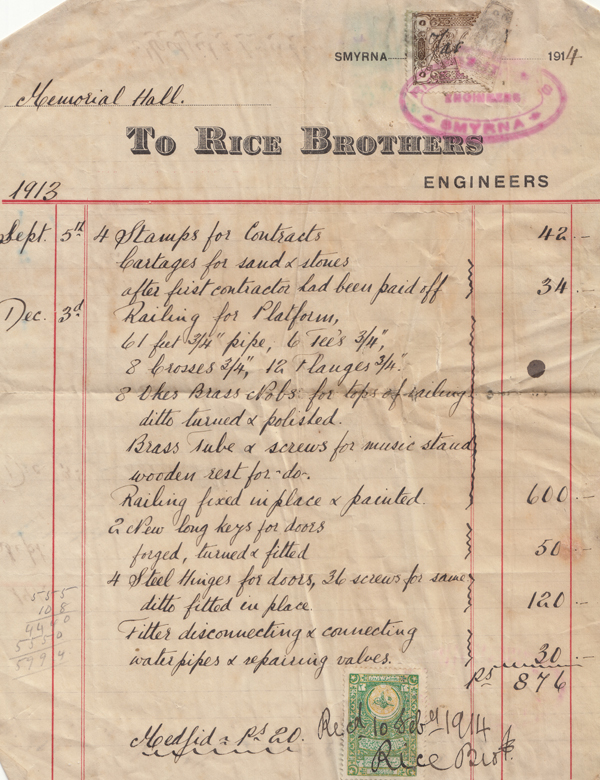
A detailed invoice by the local Levantine firm Rice Brothers who supplied the various fittings and iron-ware for the Memorial Hall, 1914.
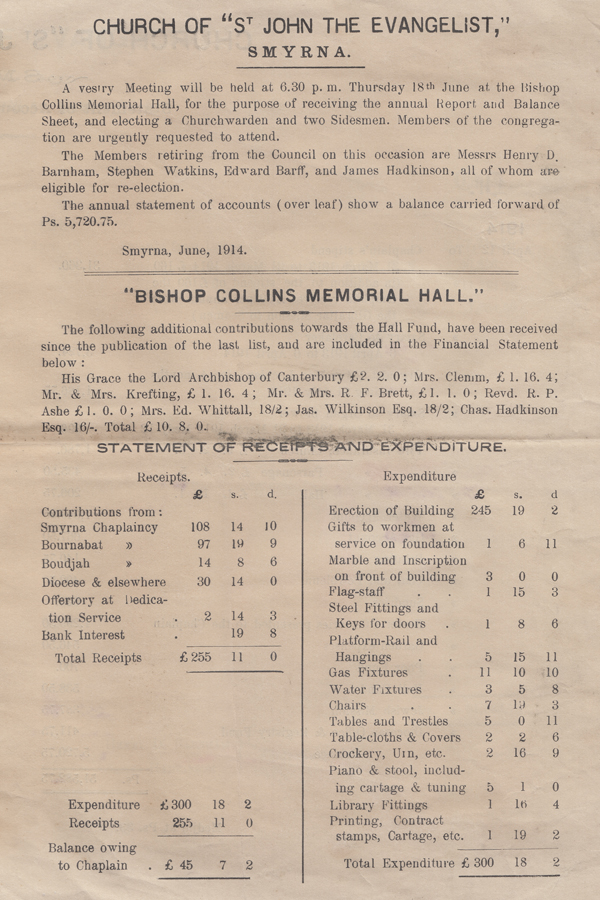
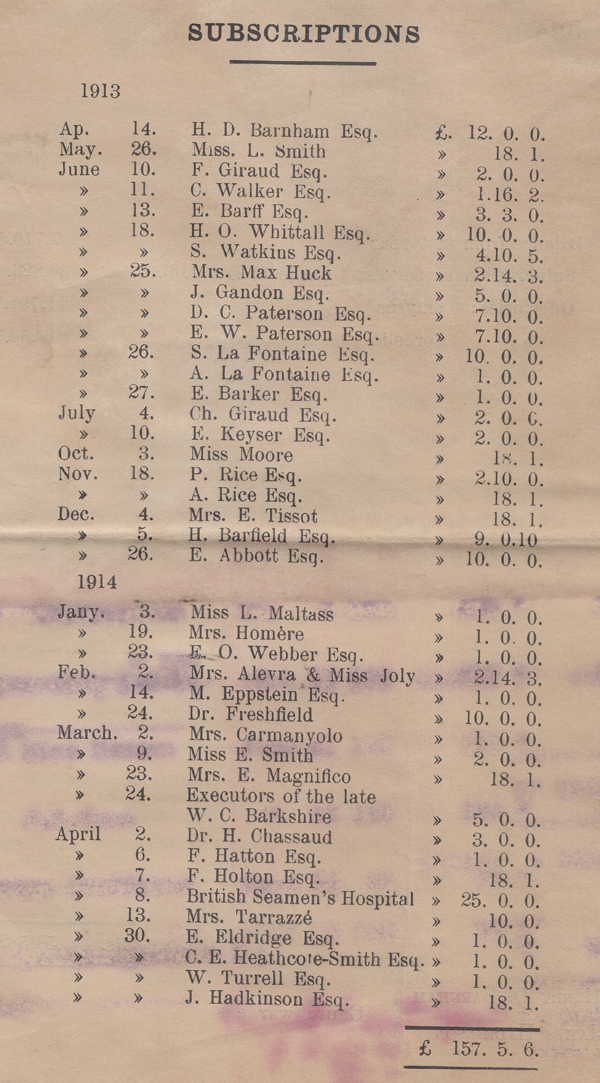
June 1914 St John Church report on receipts and expenditures with a break-down on subscription contributions.
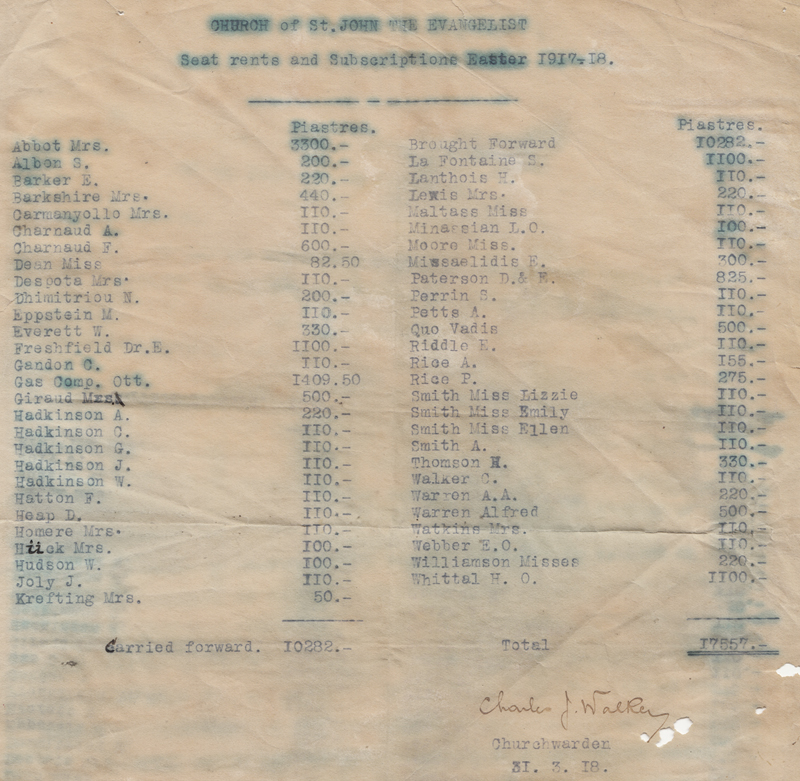
Church of St John the Evangelist, seat rents and subscriptions Easter 1917-18 period breakdown.

A letter addressed to the Anglican Chaplain of the time, Reverend Lucius Fry from Miss Gladys Routh, dated 21 January 1921, trying to clear objections for a dance class at the church hall, possibly sullied by gossip from some members of the congregation. She stated ‘Smyrna is a very difficult place owing to its lack of public institutions - as you must have found out for yourself by now - for young men and women to meet socially and have pleasant and innocent intercourse together. A Church Hall is peculiarly adapted to such intercourse; I would have thought that the Church Council would be only too pleased to see the Memorial Hall used by the young men and women of the congregation and I sincerely hope it will not put its veto on these classes of ours which I am glad to think have yours and Mr. Ashe’s [Rev. Robert Pickering Ashe - info] approval.’. Ms Routh was for many years later the secretary of the church in Boudjah. According to the contributor the late Rose Marie Caporal, ‘A life long lesbian, though respected, she moved to Bornova in 1953 from her house near the Buca train station, and is buried abroad.’
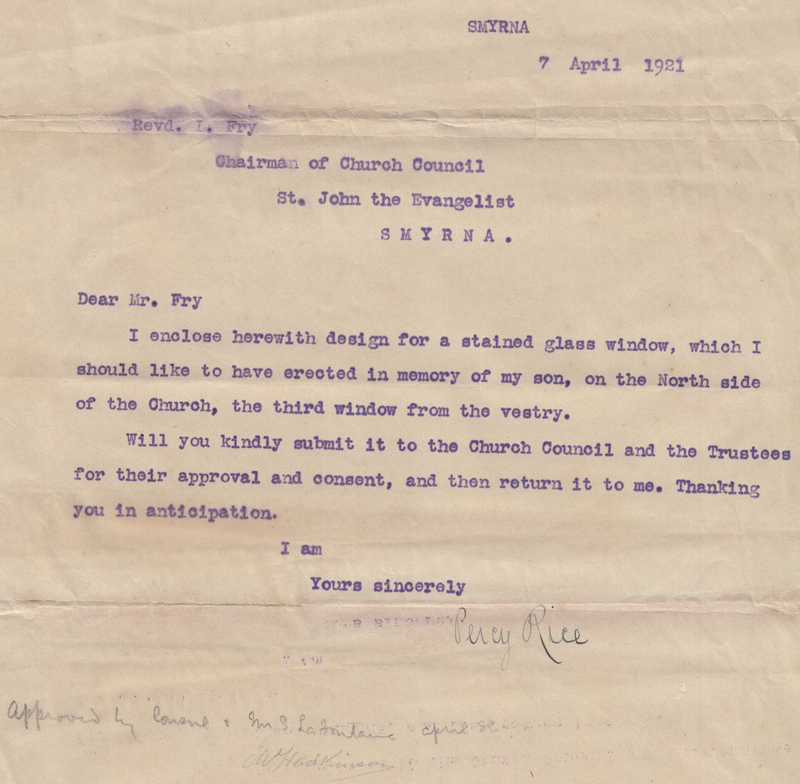
A request letter dated 7 April 1921 from Percy Rice, the father of the WWI dead Cecil Pierce Rice, Corporal who died in WWI (Boulogne, France, 1915) to the Reverend L. Fry and the Church Committee for the erection of a memorial church window. From the pencil marks at the bottom it appears this was approved the following day by members of the committee: ?, Mr S. La Fontaine, J.w. Hadkinson. The memorial window is still standing - gallery:
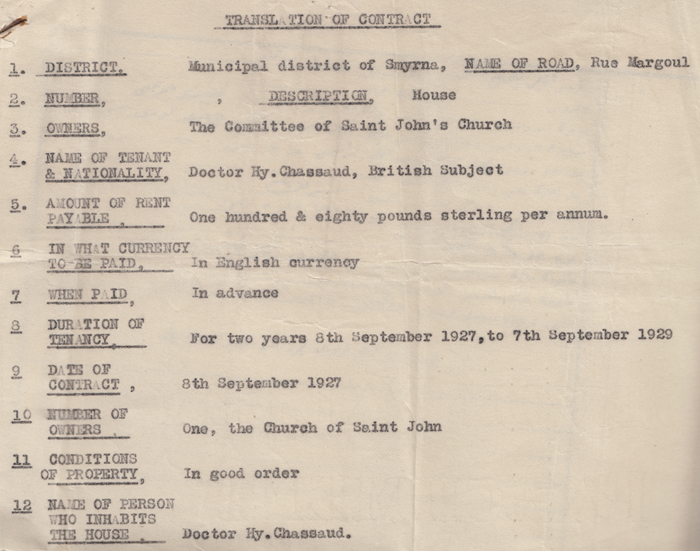
A translation of a rental contract between Doctor Hy. Chassaud and the Committee of St John’s Church for 2 years of 1927-29 - it is not clear if Dr. Chassaud is from the same family as Chasseaud.
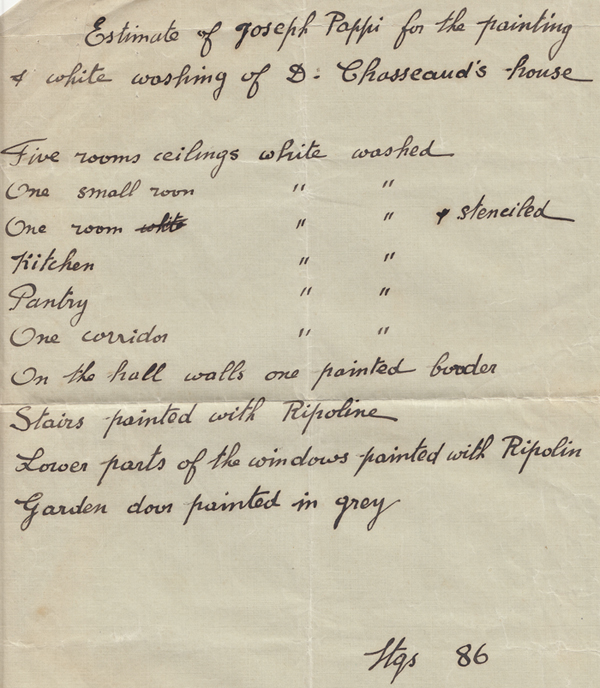
An undated estimate for the painting and whitewashing of Dr. Chasseaud’s house (presumably the same person and house as above) by the local Levantine Joseph Papi.
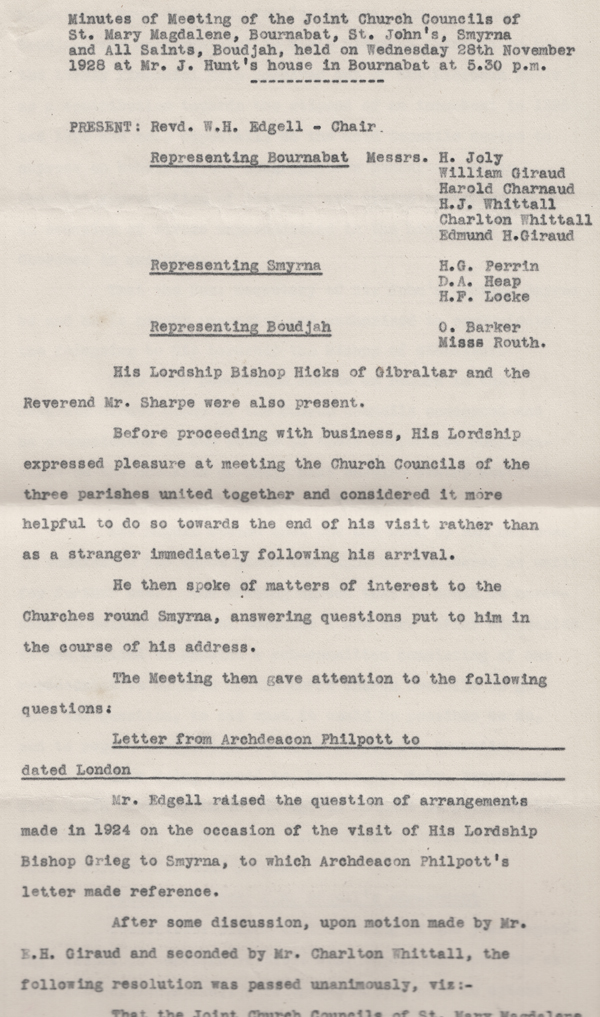
Minutes of the meeting of the joint Church Councils of St. Mary Magdalene, Bournabat, St. John's, Smyrna and All Saints, Boudjah, 28 November 1928. The names indicate the leading members of the community and their church of interest / responsibility, probably coinciding with their residence neighbourhood.
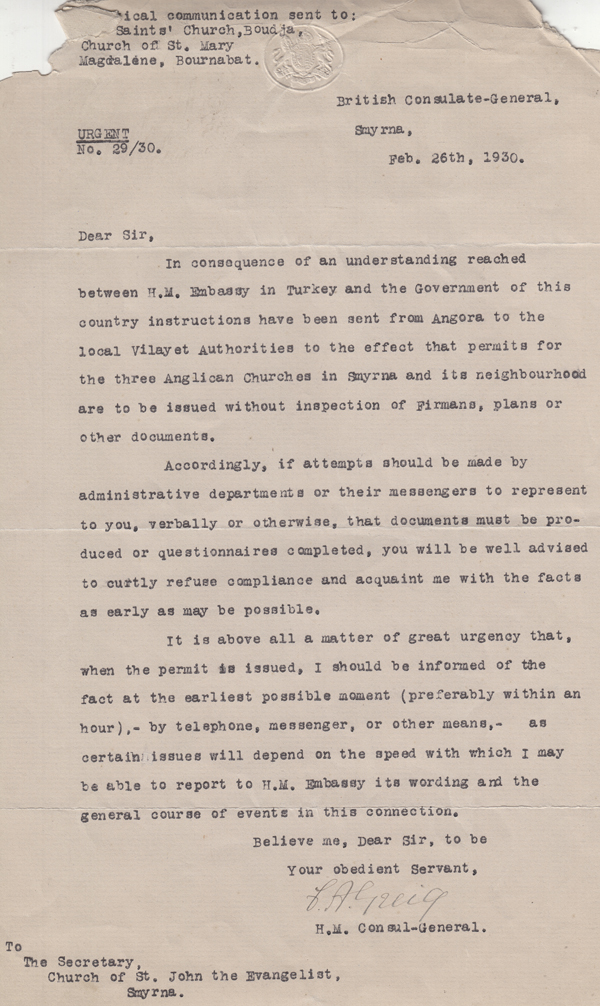
A consular document informing the 3 Anglican church authorities that instructions have been sent from the capital to the local authorities allowing for the Anglican churches to be issued permission to practice documents and advising to ‘curtly refuse compliance’ and wishing to be informed ‘preferably within an hour’ when the church committee receive the permits, showing the urgency with which this matter was viewed at the time. Other church documents do show a high degree of intransigence on the part of local government authorities wishing to view deeds etc., part of a bullying perhaps with an eye to obtain real estate for free.
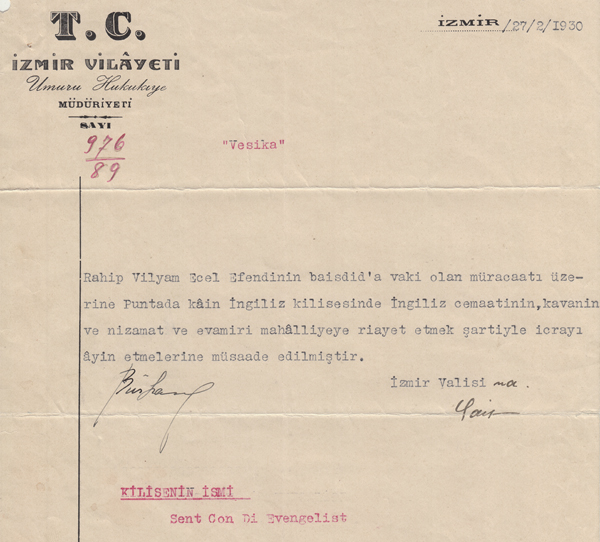
Document from the governor of Izmir, issued a day after the consular warning instruction, in reply from a request by Rev Edgell, February 1930, allowing continued use of St. John by its community as long as it is for worship. It is interesting even at this date 8 years after the Great Fire officials still referred to the neighbourhood by its former name of Punta, at least in this document.
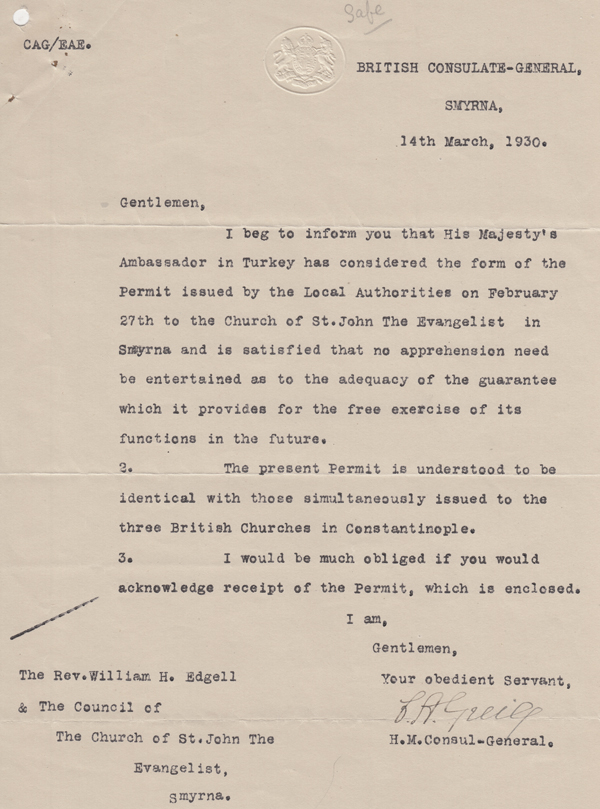
14 March 1930 dated consular document assuring the church authorities that the permit from Turkish authorities for the continued use of the church building for worship and being identical with those simultaneously issued to the three British Churches in Constantinople (St. Helena Chapel, Crimean Memorial Church, All Saints Moda).
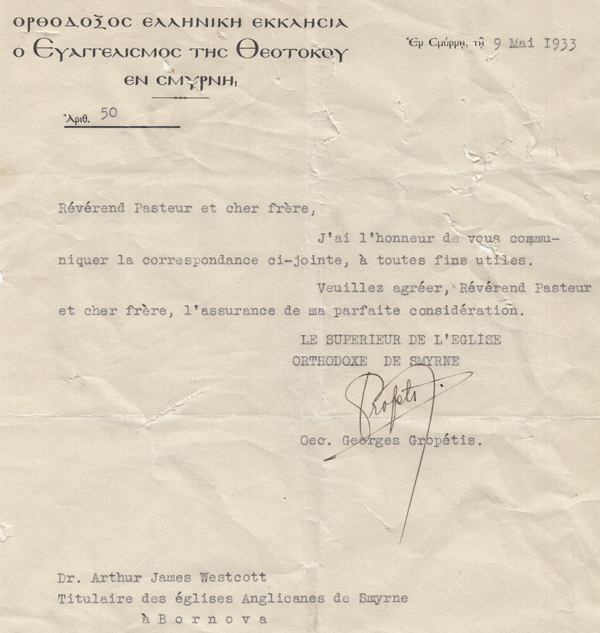
Letter of introduction from the Greek Orthodox Provost of Izmir George Gropetis to Dr. Arthur Westcott, Anglican Chaplain of Bornova, sent May 1933, presumably a short time after the Turkish authorities allowed for the Orthodox community representation and perhaps the provost was looking for a church to use for renewed services post 1922. The Orthodox Church mentioned in the upper left in Greek ‘Evangelismos tis Theotokou’, or Annunciation of the Virgin, was probably located in the upper floor of the building of the Greek Consulate at that time, i.e. the building immediately to the north of the current consulate, currenty undergoing renovation. The Orthodox population of Izmir at the time were presumably very small and somewhat hidden and they would have been mostly foreign passport holders. In the early 1950s the Dutch authorities allowed for their vacant chapel in the city to be used for services by this community, then named Agia Fotini and still functioning as such today.
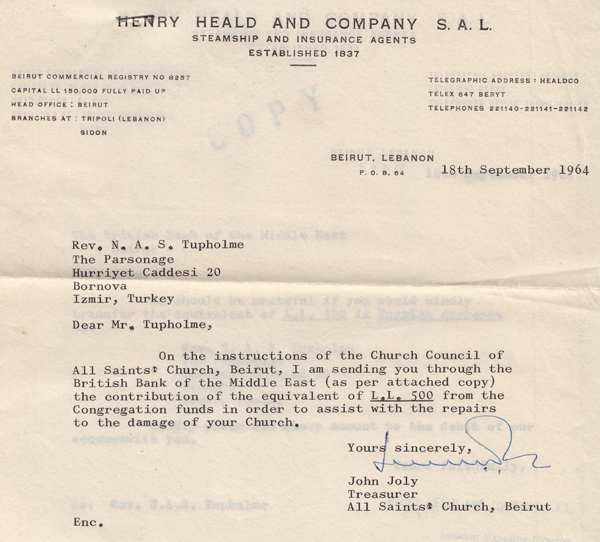
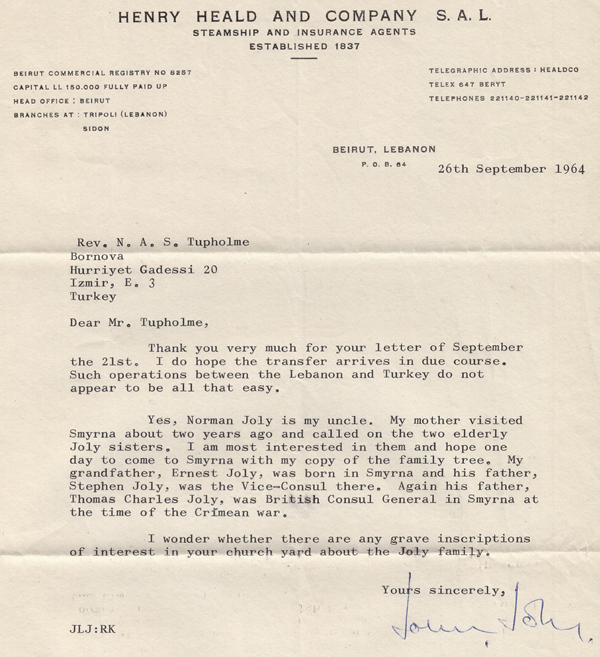
Letter sent from John Joly of the Henry Heald and Company of Beirut still trading today, whose family hailed from Smyrna, and offering funds following and appeal by the St. John’s Church committee following a mob attack on the church earlier in the year that caused massive damage. The mob chose the church as a target as it saw Britain as partly culpable for the ethnic tensions in Cyprus and aimed to burn down the whole building.
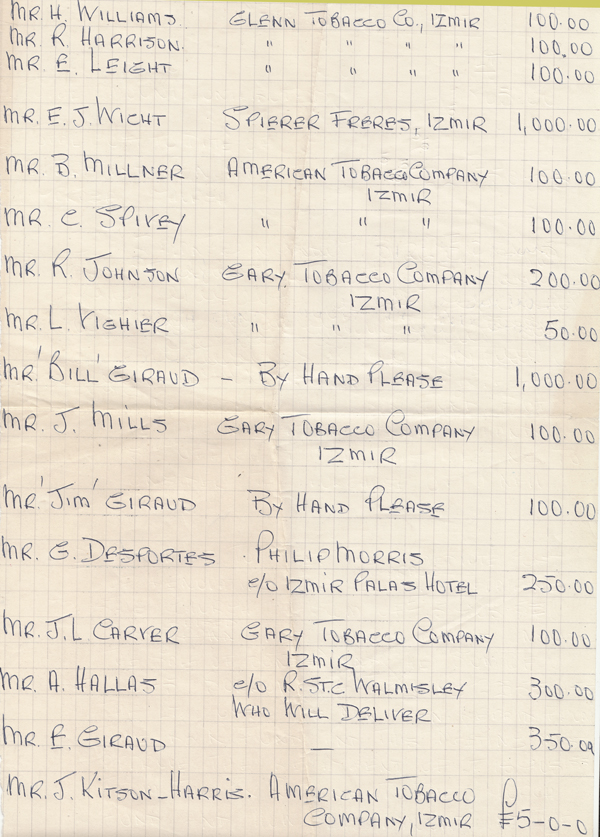
A listing of the donors to the church post the August 1964 riotous break-in, with a mixture of Levantines and British / American businessmen mostly engaged in the tobacco trade that was huge at the time. Turkish grown tobacco was / is a vital ingredient as its superior flavour meant it was a vital part of virtually all blends.

